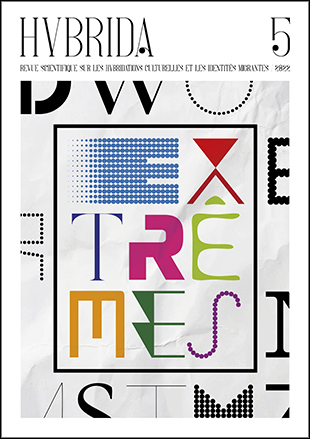Discursive analysis of interlanguage in Koffi Kwahulé’s ‘Babyface’: plurilinguism, positioning and carnavalesque scenegraphy
DOI:
https://doi.org/10.7203/HYBRIDA.5(12/2022).25374Keywords:
carnavalisation, enunciation scene, hybridity, polyphony Abstract
Abstract
The novelists of the new generation are unashamedly violating the grammatical norm. This kind of discourse, which in the second half of the 20th century seemed to be an innovation in Black African literature, has become a norm at the beginning of the 21st century. The work by K. Kwahulé is part of this trend. Babyface is a novel constructed in bric-broc. The discourse is an interweaving of disparate linguistic and social phenomena composed against a jazz background. The architectonics of the novel is characterised by its chaotic dimension. This discursive jumble reveals the marks of carnival, a symbol of extreme hybridity. The scene of enunciation of this chaos is characterised by eschatological and scatological writing. This writing, which is characteristic of unreason and violence, appears as a textual tsunami. The aim of this article is twofold. It aims to highlight the extreme hybridity in the African novel and to show the mechanism by which carnivalisation contributes to the renewal of novel writing.
 Downloads
Downloads
 References
References
Bakhtine, M. (1978). Esthétique et théorie du roman. Gallimard.
Bakhtine, M. (1978). L’Oeuvre de François Rebelais et la culture populaire du Moyen-âge et de la Renaisance. Gallimard.
Bakhtine, M. (1998). Problèmes de la poétique de Dostoïevski. Seuil.
Combe, D. (1995). Poétique francophone. Hachette.
Coulibaly, D. (2019). Regard stylistique et comparatif des pratiques diglossiques dans Féerie pour une autre fois de Louis-Ferdinand Céline et Le Lieutenant de Kouta de Massa Makan Diabaté : deux romans d’expression française. Nordic Journal of Francophone Studies/Revue Nordique des Études Francophones, 2(1), 1–11. https://doi.org/10.16993/rnef.19
Kourouma, A. (1968). Les Soleils des indépendances. Presses de l’Université de Montréal.
Kourouma, A. (1995). Les Soleils des indépendances. Seuil, coll. « Points ».
Koffi, K. (2006). Babyface. Gallimard.
Kristeva, J. (1969). Semeiotikè : Recherche pour une sémanalyse. Seuil.
Maingueneau, D. (2004). Le Discours littéraire. Paratopie et scène d’énonciation. Armand Colin.
N’da, P. (2003). L’Écriture romanesque de Maurice Bandaman ou la quête d’une esthétique africaine. L’Harmattan.
Ouologuem, Y. (1968). Le Devoir de violence. Les Éditions du Seuil.
Schaeffer (J.-M.). (1995). « Énonciation théâtrale ». In O. Ducrot & J.-M. Schaeffer. Nouveau dictionnaire encyclopédique des sciences du langage (pp. 740–752). Seuil.
Published
How to Cite
-
Abstract375
-
HTML (Français )443
-
PDF (Français )265
Issue
Section
License
![]()
All the documents in the OJS platform are open access and property of their respective authors.
Authors publishing in the journal agree to the following terms:
- Authors keep the rights and guarantee HYBRIDA the right to be the first publication of the document, licensed under a Creative Commons license Attribution-NonCommercial-ShareAlike 4.0 International (CC BY-NC-SA 4.0) that allows others to share the work with an acknowledgement of authorship and publication in the journal.
- Authors are allowed and encouraged to spread their work (once published) through electronic means using personal or institutional websites (institutional open archives, personal websites or professional and academic networks profiles) once the text has been published.
















